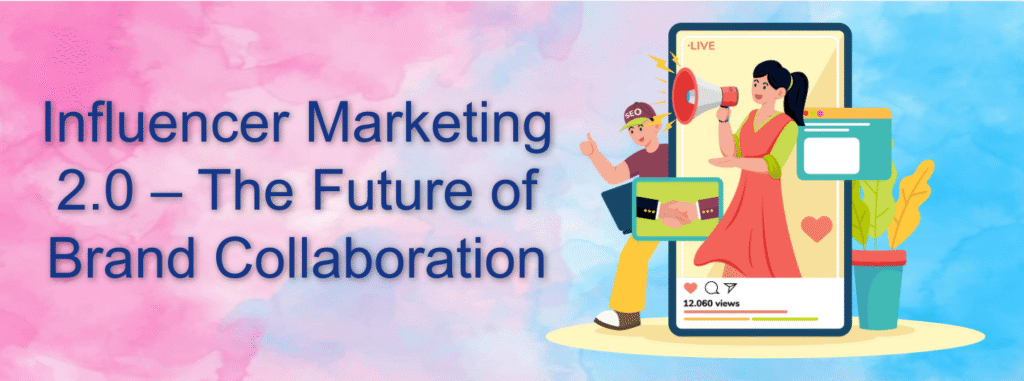Influencer Marketing 2.0 – The Future of Brand Collaboration

Influencer Marketing 2.0 – The Next Evolution
In 2025, Influencer Marketing 2.0 has emerged as a more authentic, data-driven, and performance-oriented strategy. Businesses are shifting focus from vanity metrics to real engagement, conversions, and long-term partnerships with influencers who genuinely connect with audiences.
This new wave is powered by AI analytics, micro and nano influencers, user-generated content, and sustainability-focused collaborations. Let’s dive into how Influencer Marketing 2.0 is redefining digital branding.
1. From Popularity to Authenticity
The earlier phase of influencer marketing was dominated by follower counts. However, consumers are now smarter—they value trust and relatability over popularity.
- Audiences prefer real-life experiences shared by influencers who actually use the product.
- Authentic reviews and personal stories generate higher conversions than generic sponsored posts.
- Brands are focusing on influencers who align with their values rather than just their numbers.
Example: A skincare brand collaborates with a local dermatologist-influencer who explains product benefits in detail rather than a celebrity simply posing with the product.
2. Rise of Micro and Nano Influencers
Micro-influencers (10,000–100,000 followers) and Nano-influencers (under 10,000 followers) are driving Influencer Marketing 2.0.
- They have higher engagement rates (often 5–10x more than mega influencers).
- Their audiences see them as approachable and trustworthy.
- Costs are lower, making them ideal for local businesses and startups.
Agra Example: A café in Agra partners with 10 local food bloggers instead of one celebrity chef. The result? Stronger local buzz and higher walk-ins.
3. Performance-Based Partnerships
Instead of paying influencers flat fees, brands are moving toward performance-based models.
- Payment is based on clicks, conversions, or sales generated.
- This ensures accountability and ROI-focused campaigns.
- Influencers also work harder to drive results, as their earnings are directly tied to performance.
Pro Tip: Use affiliate codes, trackable links, or UTM parameters to measure influencer performance.
4. AI-Powered Influencer Analytics
Artificial Intelligence is taking influencer marketing to the next level.
- AI tools analyze audience demographics, engagement patterns, and sentiment.
- Brands can identify influencers with real engagement vs. fake followers.
- Predictive analytics helps brands forecast ROI before starting campaigns.
Popular Tools: HypeAuditor, Influencity, and Upfluence are helping marketers choose the right influencers with data-backed insights
5. Multi-Platform Influence
Influencers are no longer restricted to Instagram. In 2025, multi-platform presence is essential.
- Instagram & TikTok – short videos, reels, lifestyle posts.
- YouTube – long-form tutorials, reviews, and storytelling.
- LinkedIn – B2B influencer marketing for professional industries.
- Podcasts & Blogs – deep-dive product reviews and thought leadership.
Trend: Brands prefer influencers who create content across 2–3 platforms for wider visibility.
6. Employee & Customer Influencers
A new form of influencer marketing is emerging where employees and loyal customers become brand advocates.
- Employees create behind-the-scenes content to humanize brands.
- Loyal customers share unfiltered experiences, boosting credibility.
- Referral-based influencer programs reward customers for sharing products online.
- Example: Starbucks encourages customers to share photos with seasonal drinks, creating viral user-generated campaigns.
7. Storytelling Over Selling
Influencer Marketing 2.0 is storytelling-driven. Hard selling doesn’t work anymore—audiences expect value-based, emotional, and entertaining content.
- Influencers weave brand messages into daily life stories.
- Tutorials, challenges, and experiences replace static ads.
- Brands encourage influencers to use their unique voice and style instead of scripted promotions.
Example: A fitness influencer documents their 30-day journey with a protein brand, sharing real progress instead of just endorsing it once.
8. Live Commerce & Shoppable Content
In 2025, live streaming + influencer marketing = instant sales.
- Influencers host live product demos on Instagram, YouTube, and Facebook.
- Audiences can purchase products instantly with shoppable links.
- Live Q&A builds trust and clears doubts in real time.
China Example: Live commerce already contributes billions in sales through influencers. India is catching up fast with this trend.
9. Focus on Niche Communities
Influencers with niche expertise are gaining more importance than general lifestyle influencers.
- Finance, health, travel, food, parenting, and gaming are growing niches.
- Brands prefer smaller, targeted audiences instead of mass exposure.
- Communities like Discord, Telegram, and niche Facebook Groups are becoming marketing hubs.
Pro Insight: A fintech app collaborates with finance YouTubers who explain investments instead of generic lifestyle bloggers.
10. Ethical & Sustainable Collaborations
Modern consumers want brands to be ethical, sustainable, and socially responsible. Influencers who stand for causes gain more trust.
- Eco-friendly, cruelty-free, and fair-trade brand partnerships are in demand.
- Influencers highlight social impact initiatives like women empowerment or education.
- Authentic activism resonates strongly with Gen Z and Millennials.
Example: A clothing brand partners with sustainability influencers to promote eco-friendly fabrics.
11. Influencer-Brand Long-Term Partnerships
Short one-time collaborations are giving way to long-term contracts.
- Continuous partnerships build brand trust and consistency.
- Influencers become brand ambassadors rather than just promoters.
- Audiences see genuine loyalty when influencers repeatedly endorse a brand.
Pro Tip: Sign 6–12 month influencer contracts to strengthen audience recall.
12. Measuring ROI in Influencer Marketing 2.0
Unlike the early days, ROI tracking is now critical. Brands measure:
- Engagement rate (likes, comments, shares)
- Click-through rate (CTR)
- Conversion rate (sales, sign-ups)
- Cost per acquisition (CPA)
Tools: Google Analytics, Meta Ads Manager, and influencer platforms help brands calculate returns accurately.
Conclusion
Influencer Marketing 2.0 is authentic, data-driven, and performance-oriented. It focuses on trust over reach, storytelling over selling, and value over vanity.
For businesses in 2025, collaborating with the right influencers isn’t about spending big on celebrities—it’s about finding voices that truly resonate with audiences.
At Awaraj, we help brands connect with authentic influencers, design ROI-focused campaigns, and leverage data to drive measurable results. The future of influencer marketing is already here—are you ready to embrace it?
USEFUL LINKS:
https://awaraj.com/digital-marketing-services/
https://sproutsocial.com/insights/influencer-marketing/
https://tapfiliate.com/blog/influencer-marketing-trends/?utm_source=chatgpt.com
https://influencermarketinghub.com/influencer-marketing-benchmark-report/?utm_source=chatgpt.com

